engine FORD E SERIES 2004 4.G Owner's Manual
[x] Cancel search | Manufacturer: FORD, Model Year: 2004, Model line: E SERIES, Model: FORD E SERIES 2004 4.GPages: 240, PDF Size: 3.62 MB
Page 117 of 240
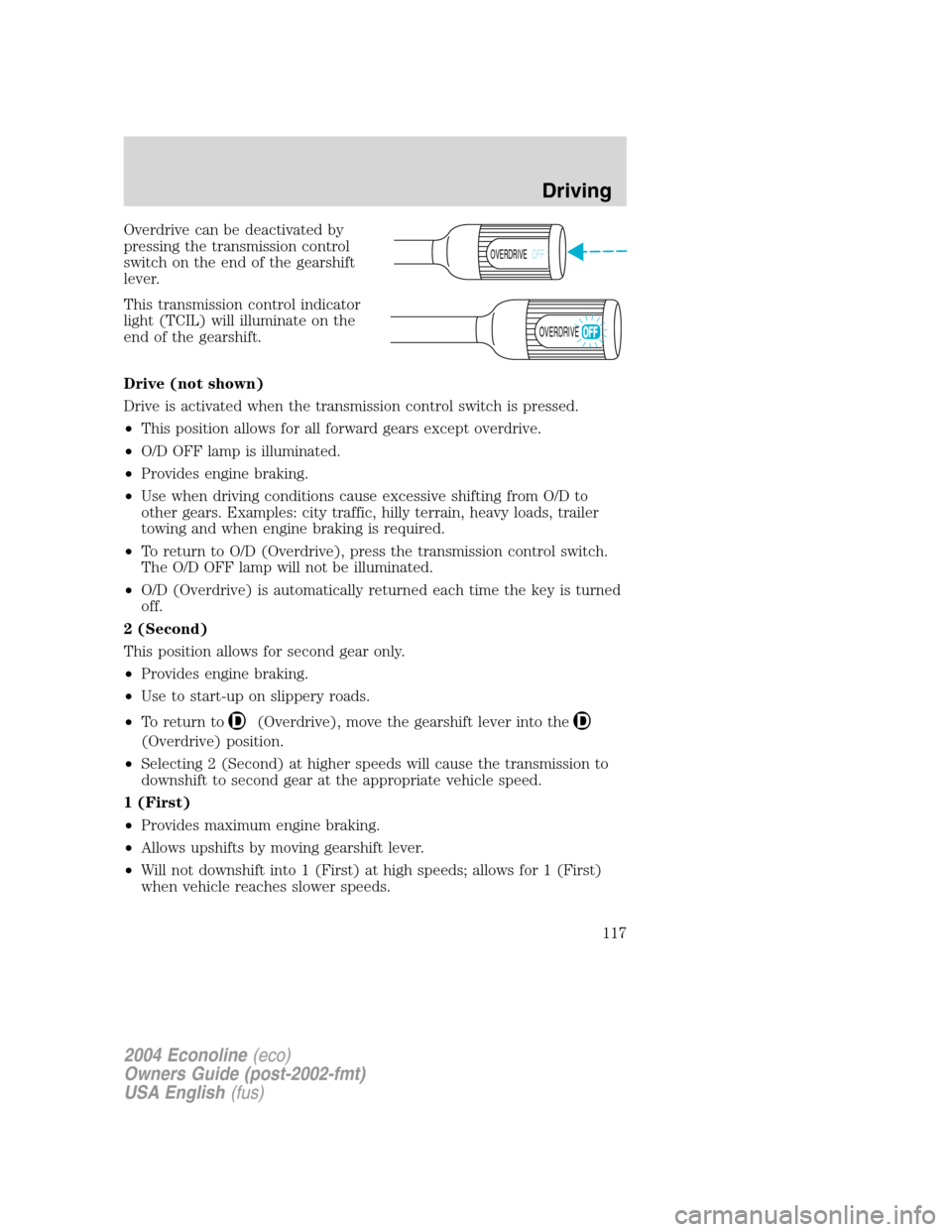
Overdrive can be deactivated by
pressing the transmission control
switch on the end of the gearshift
lever.
This transmission control indicator
light (TCIL) will illuminate on the
end of the gearshift.
Drive (not shown)
Drive is activated when the transmission control switch is pressed.
•This position allows for all forward gears except overdrive.
•O/D OFF lamp is illuminated.
•Provides engine braking.
•Use when driving conditions cause excessive shifting from O/D to
other gears. Examples: city traffic, hilly terrain, heavy loads, trailer
towing and when engine braking is required.
•To return to O/D (Overdrive), press the transmission control switch.
The O/D OFF lamp will not be illuminated.
•O/D (Overdrive) is automatically returned each time the key is turned
off.
2 (Second)
This position allows for second gear only.
•Provides engine braking.
•Use to start-up on slippery roads.
•To return to
(Overdrive), move the gearshift lever into the
(Overdrive) position.
•Selecting 2 (Second) at higher speeds will cause the transmission to
downshift to second gear at the appropriate vehicle speed.
1 (First)
•Provides maximum engine braking.
•Allows upshifts by moving gearshift lever.
•Will not downshift into 1 (First) at high speeds; allows for 1 (First)
when vehicle reaches slower speeds.
OVERDRIVEOFF
OVERDRIVE
2004 Econoline(eco)
Owners Guide (post-2002-fmt)
USA English(fus)
Driving
117
Page 119 of 240
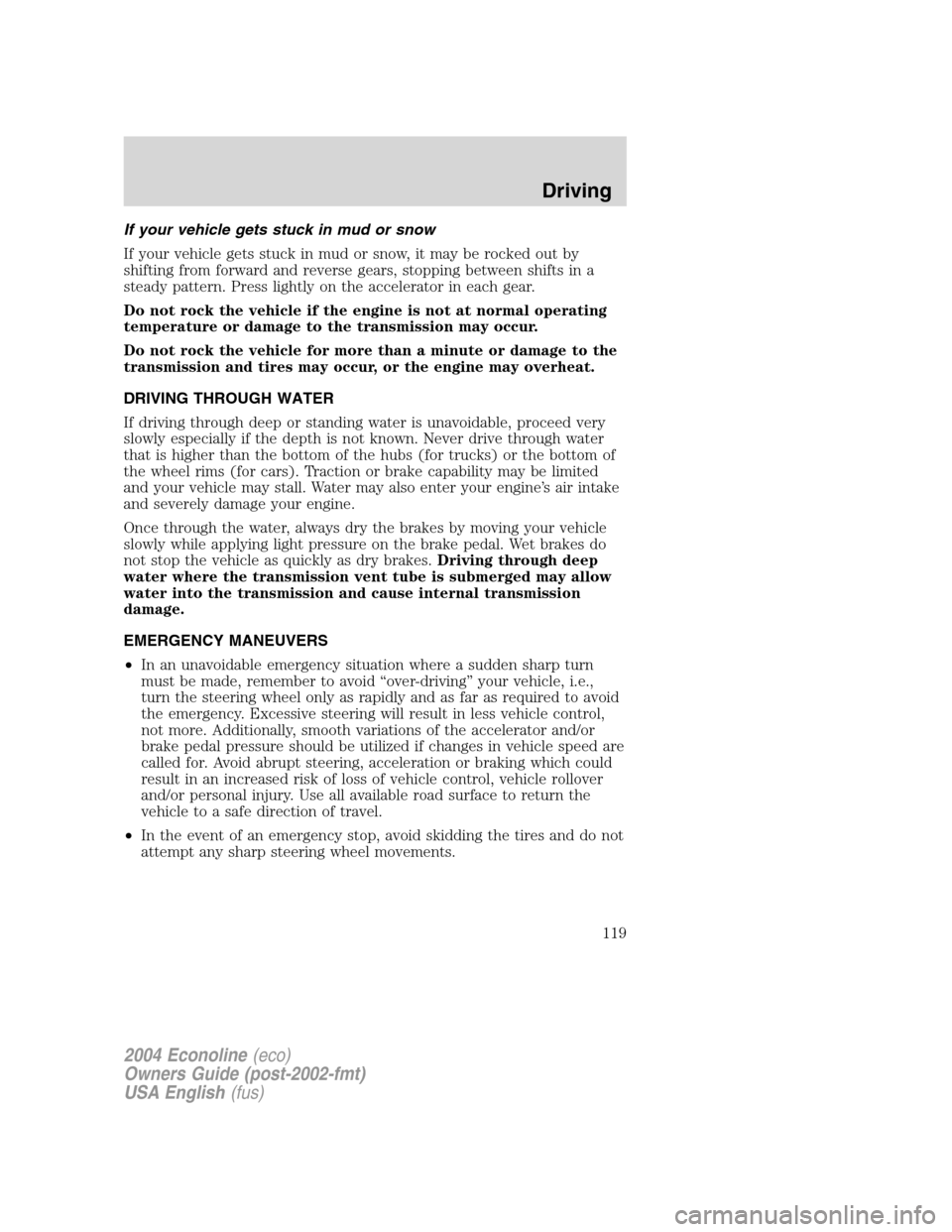
If your vehicle gets stuck in mud or snow
If your vehicle gets stuck in mud or snow, it may be rocked out by
shifting from forward and reverse gears, stopping between shifts in a
steady pattern. Press lightly on the accelerator in each gear.
Do not rock the vehicle if the engine is not at normal operating
temperature or damage to the transmission may occur.
Do not rock the vehicle for more than a minute or damage to the
transmission and tires may occur, or the engine may overheat.
DRIVING THROUGH WATER
If driving through deep or standing water is unavoidable, proceed very
slowly especially if the depth is not known. Never drive through water
that is higher than the bottom of the hubs (for trucks) or the bottom of
the wheel rims (for cars). Traction or brake capability may be limited
and your vehicle may stall. Water may also enter your engine’s air intake
and severely damage your engine.
Once through the water, always dry the brakes by moving your vehicle
slowly while applying light pressure on the brake pedal. Wet brakes do
not stop the vehicle as quickly as dry brakes.Driving through deep
water where the transmission vent tube is submerged may allow
water into the transmission and cause internal transmission
damage.
EMERGENCY MANEUVERS
•In an unavoidable emergency situation where a sudden sharp turn
must be made, remember to avoid“over-driving”your vehicle, i.e.,
turn the steering wheel only as rapidly and as far as required to avoid
the emergency. Excessive steering will result in less vehicle control,
not more. Additionally, smooth variations of the accelerator and/or
brake pedal pressure should be utilized if changes in vehicle speed are
called for. Avoid abrupt steering, acceleration or braking which could
result in an increased risk of loss of vehicle control, vehicle rollover
and/or personal injury. Use all available road surface to return the
vehicle to a safe direction of travel.
•In the event of an emergency stop, avoid skidding the tires and do not
attempt any sharp steering wheel movements.
2004 Econoline(eco)
Owners Guide (post-2002-fmt)
USA English(fus)
Driving
119
Page 121 of 240
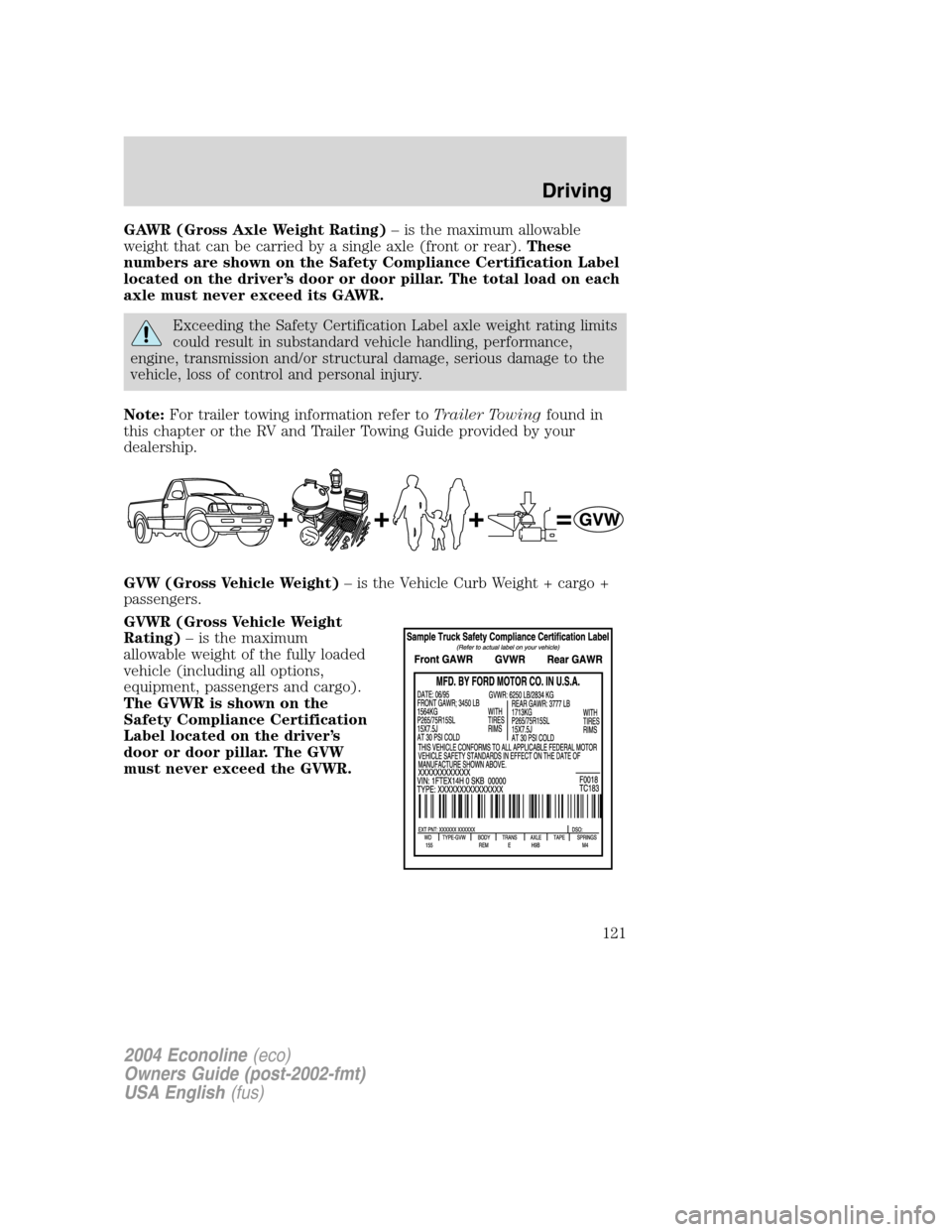
GAWR (Gross Axle Weight Rating)–is the maximum allowable
weight that can be carried by a single axle (front or rear).These
numbers are shown on the Safety Compliance Certification Label
located on the driver’s door or door pillar. The total load on each
axle must never exceed its GAWR.
Exceeding the Safety Certification Label axle weight rating limits
could result in substandard vehicle handling, performance,
engine, transmission and/or structural damage, serious damage to the
vehicle, loss of control and personal injury.
Note:For trailer towing information refer toTrailer Towingfound in
this chapter or the RV and Trailer Towing Guide provided by your
dealership.
GVW (Gross Vehicle Weight)–is the Vehicle Curb Weight + cargo +
passengers.
GVWR (Gross Vehicle Weight
Rating)–is the maximum
allowable weight of the fully loaded
vehicle (including all options,
equipment, passengers and cargo).
The GVWR is shown on the
Safety Compliance Certification
Label located on the driver’s
door or door pillar. The GVW
must never exceed the GVWR.
2004 Econoline(eco)
Owners Guide (post-2002-fmt)
USA English(fus)
Driving
121
Page 122 of 240
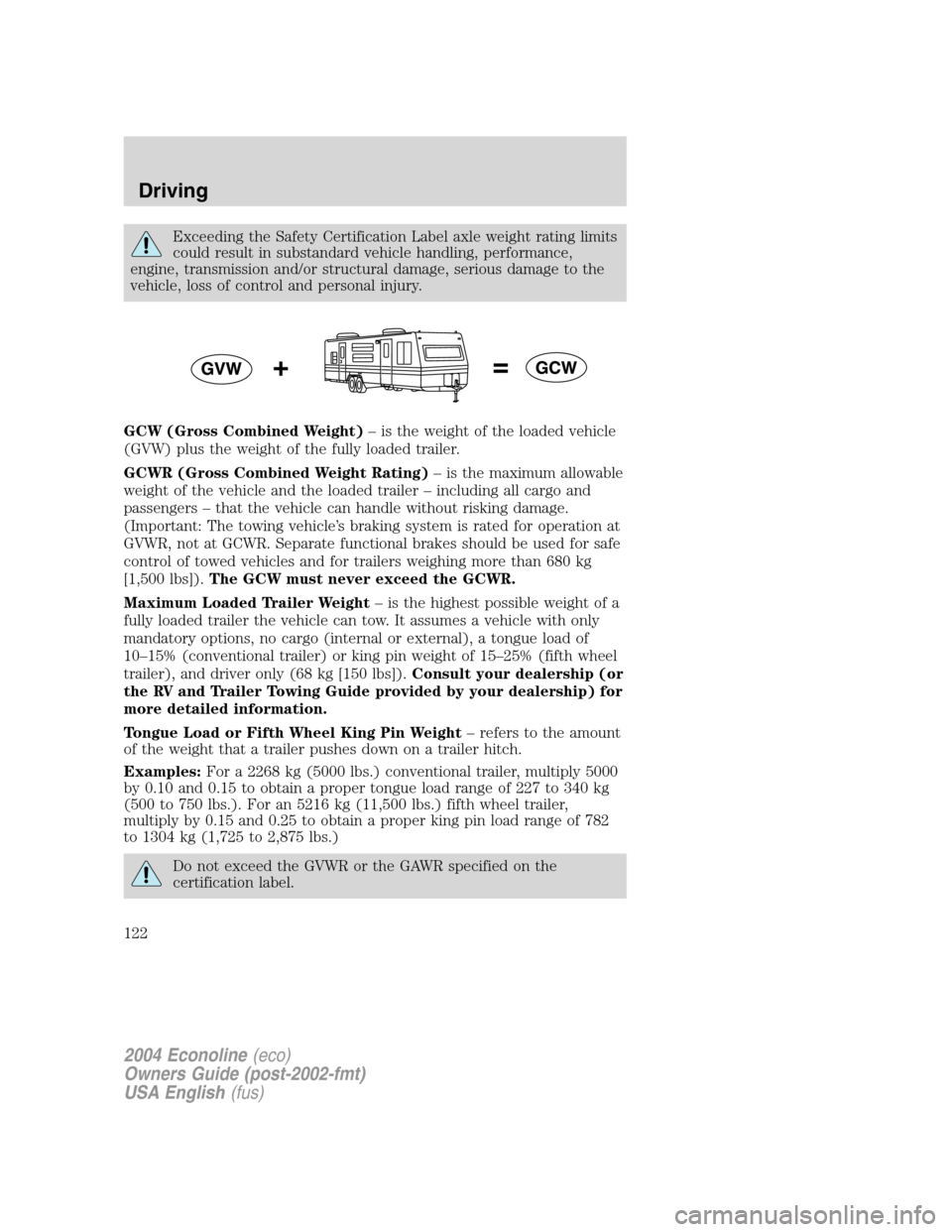
Exceeding the Safety Certification Label axle weight rating limits
could result in substandard vehicle handling, performance,
engine, transmission and/or structural damage, serious damage to the
vehicle, loss of control and personal injury.
GCW (Gross Combined Weight)–is the weight of the loaded vehicle
(GVW) plus the weight of the fully loaded trailer.
GCWR (Gross Combined Weight Rating)–is the maximum allowable
weight of the vehicle and the loaded trailer–including all cargo and
passengers–that the vehicle can handle without risking damage.
(Important: The towing vehicle’s braking system is rated for operation at
GVWR, not at GCWR. Separate functional brakes should be used for safe
control of towed vehicles and for trailers weighing more than 680 kg
[1,500 lbs]).The GCW must never exceed the GCWR.
Maximum Loaded Trailer Weight–is the highest possible weight of a
fully loaded trailer the vehicle can tow. It assumes a vehicle with only
mandatory options, no cargo (internal or external), a tongue load of
10–15% (conventional trailer) or king pin weight of 15–25% (fifth wheel
trailer), and driver only (68 kg [150 lbs]).Consult your dealership (or
the RV and Trailer Towing Guide provided by your dealership) for
more detailed information.
Tongue Load or Fifth Wheel King Pin Weight–refers to the amount
of the weight that a trailer pushes down on a trailer hitch.
Examples:For a 2268 kg (5000 lbs.) conventional trailer, multiply 5000
by 0.10 and 0.15 to obtain a proper tongue load range of 227 to 340 kg
(500 to 750 lbs.). For an 5216 kg (11,500 lbs.) fifth wheel trailer,
multiply by 0.15 and 0.25 to obtain a proper king pin load range of 782
to 1304 kg (1,725 to 2,875 lbs.)
Do not exceed the GVWR or the GAWR specified on the
certification label.
2004 Econoline(eco)
Owners Guide (post-2002-fmt)
USA English(fus)
Driving
122
Page 123 of 240
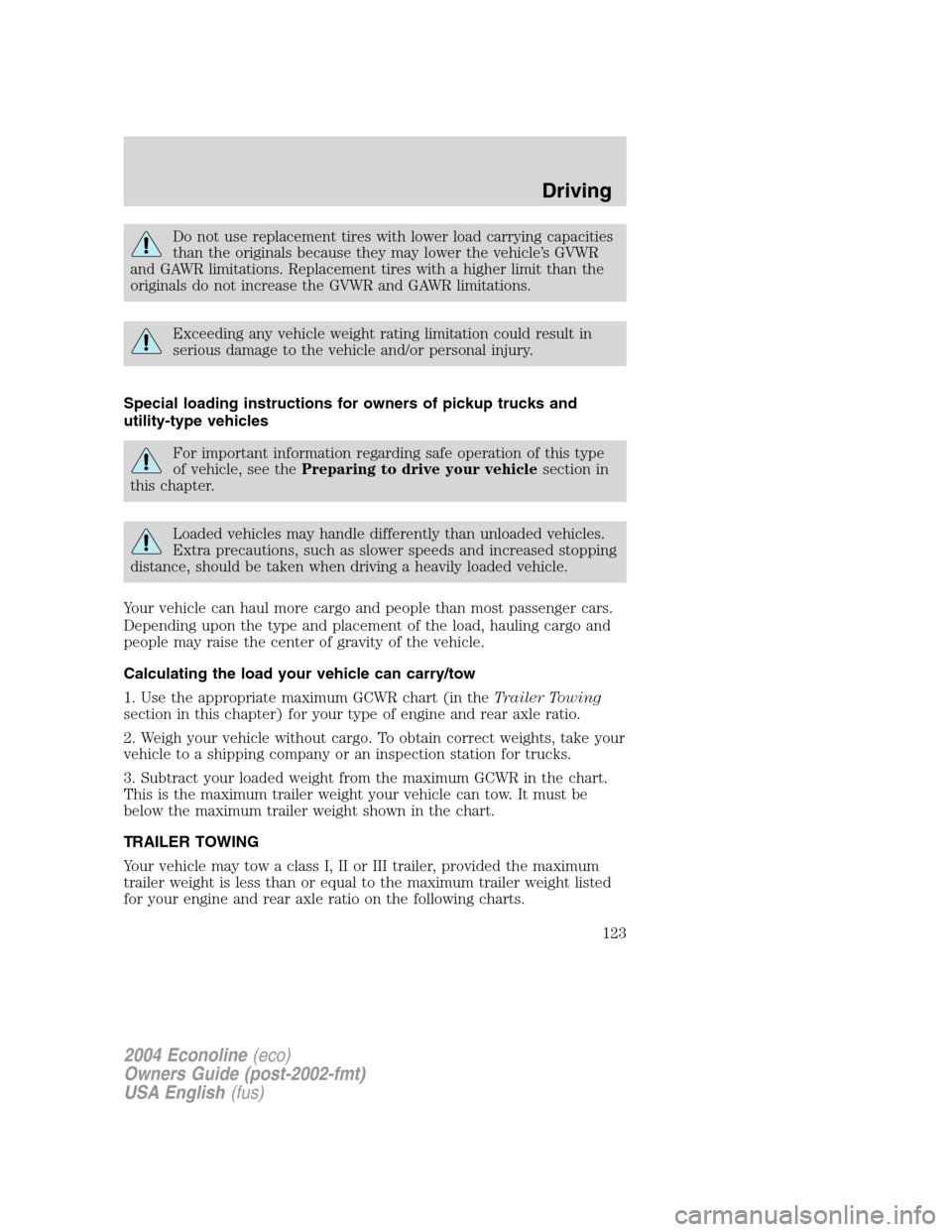
Do not use replacement tires with lower load carrying capacities
than the originals because they may lower the vehicle’s GVWR
and GAWR limitations. Replacement tires with a higher limit than the
originals do not increase the GVWR and GAWR limitations.
Exceeding any vehicle weight rating limitation could result in
serious damage to the vehicle and/or personal injury.
Special loading instructions for owners of pickup trucks and
utility-type vehicles
For important information regarding safe operation of this type
of vehicle, see thePreparing to drive your vehiclesection in
this chapter.
Loaded vehicles may handle differently than unloaded vehicles.
Extra precautions, such as slower speeds and increased stopping
distance, should be taken when driving a heavily loaded vehicle.
Your vehicle can haul more cargo and people than most passenger cars.
Depending upon the type and placement of the load, hauling cargo and
people may raise the center of gravity of the vehicle.
Calculating the load your vehicle can carry/tow
1. Use the appropriate maximum GCWR chart (in theTrailer Towing
section in this chapter) for your type of engine and rear axle ratio.
2. Weigh your vehicle without cargo. To obtain correct weights, take your
vehicle to a shipping company or an inspection station for trucks.
3. Subtract your loaded weight from the maximum GCWR in the chart.
This is the maximum trailer weight your vehicle can tow. It must be
below the maximum trailer weight shown in the chart.
TRAILER TOWING
Your vehicle may tow a class I, II or III trailer, provided the maximum
trailer weight is less than or equal to the maximum trailer weight listed
for your engine and rear axle ratio on the following charts.
2004 Econoline(eco)
Owners Guide (post-2002-fmt)
USA English(fus)
Driving
123
Page 124 of 240
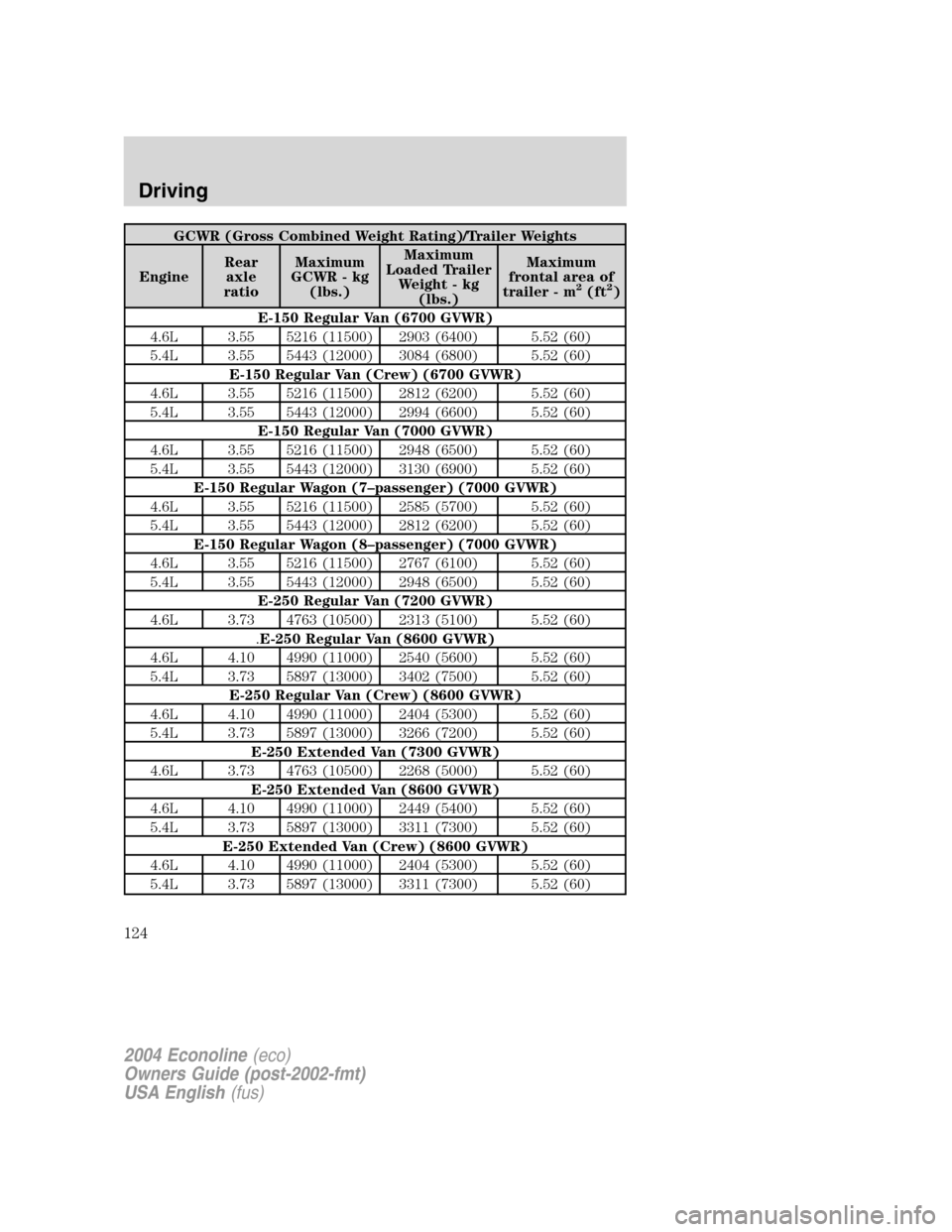
GCWR (Gross Combined Weight Rating)/Trailer Weights
EngineRear
axle
ratioMaximum
GCWR - kg
(lbs.)Maximum
Loaded Trailer
Weight - kg
(lbs.)Maximum
frontal area of
trailer - m
2(ft2)
E-150 Regular Van (6700 GVWR)
4.6L 3.55 5216 (11500) 2903 (6400) 5.52 (60)
5.4L 3.55 5443 (12000) 3084 (6800) 5.52 (60)
E-150 Regular Van (Crew) (6700 GVWR)
4.6L 3.55 5216 (11500) 2812 (6200) 5.52 (60)
5.4L 3.55 5443 (12000) 2994 (6600) 5.52 (60)
E-150 Regular Van (7000 GVWR)
4.6L 3.55 5216 (11500) 2948 (6500) 5.52 (60)
5.4L 3.55 5443 (12000) 3130 (6900) 5.52 (60)
E-150 Regular Wagon (7–passenger) (7000 GVWR)
4.6L 3.55 5216 (11500) 2585 (5700) 5.52 (60)
5.4L 3.55 5443 (12000) 2812 (6200) 5.52 (60)
E-150 Regular Wagon (8–passenger) (7000 GVWR)
4.6L 3.55 5216 (11500) 2767 (6100) 5.52 (60)
5.4L 3.55 5443 (12000) 2948 (6500) 5.52 (60)
E-250 Regular Van (7200 GVWR)
4.6L 3.73 4763 (10500) 2313 (5100) 5.52 (60)
.E-250 Regular Van (8600 GVWR)
4.6L 4.10 4990 (11000) 2540 (5600) 5.52 (60)
5.4L 3.73 5897 (13000) 3402 (7500) 5.52 (60)
E-250 Regular Van (Crew) (8600 GVWR)
4.6L 4.10 4990 (11000) 2404 (5300) 5.52 (60)
5.4L 3.73 5897 (13000) 3266 (7200) 5.52 (60)
E-250 Extended Van (7300 GVWR)
4.6L 3.73 4763 (10500) 2268 (5000) 5.52 (60)
E-250 Extended Van (8600 GVWR)
4.6L 4.10 4990 (11000) 2449 (5400) 5.52 (60)
5.4L 3.73 5897 (13000) 3311 (7300) 5.52 (60)
E-250 Extended Van (Crew) (8600 GVWR)
4.6L 4.10 4990 (11000) 2404 (5300) 5.52 (60)
5.4L 3.73 5897 (13000) 3311 (7300) 5.52 (60)
2004 Econoline(eco)
Owners Guide (post-2002-fmt)
USA English(fus)
Driving
124
Page 125 of 240
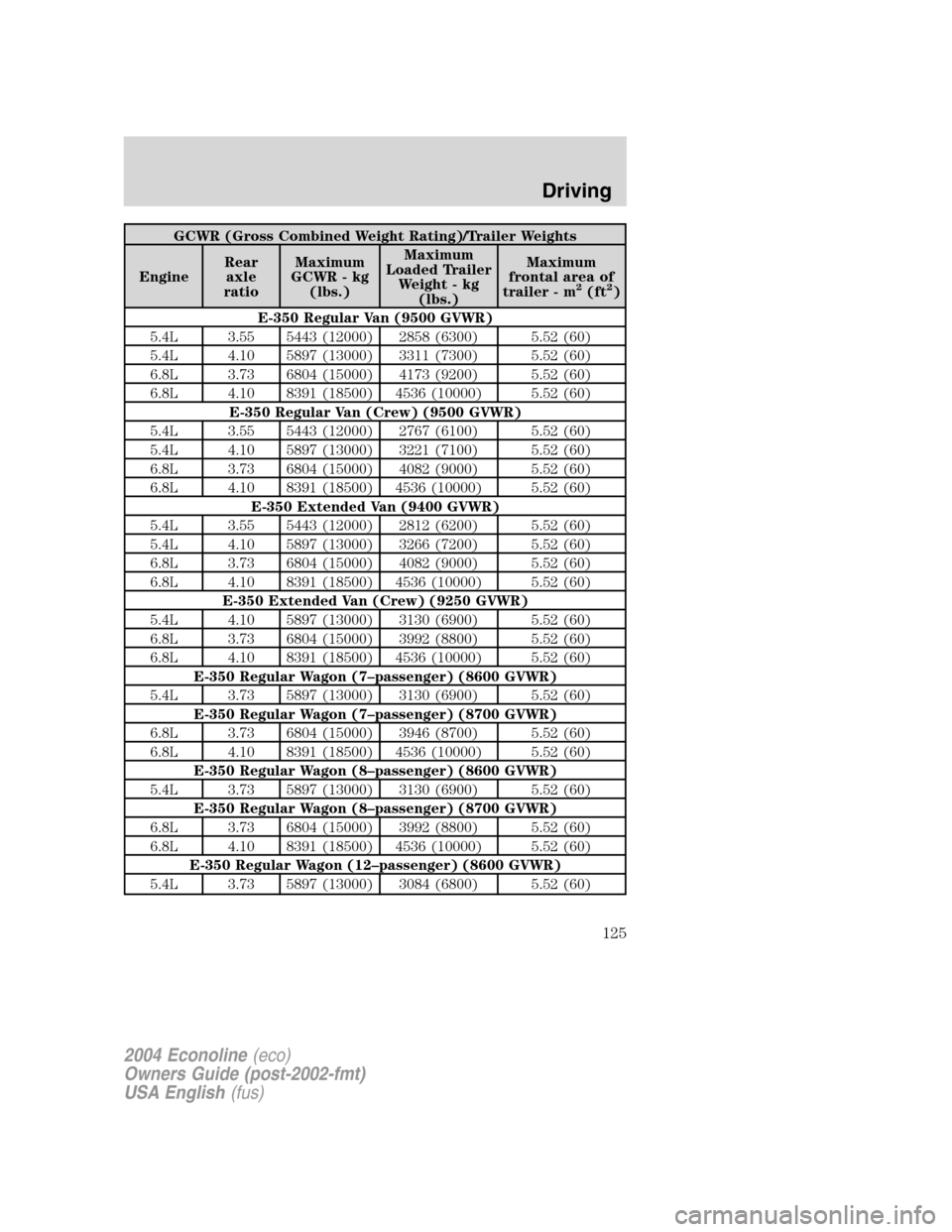
GCWR (Gross Combined Weight Rating)/Trailer Weights
EngineRear
axle
ratioMaximum
GCWR - kg
(lbs.)Maximum
Loaded Trailer
Weight - kg
(lbs.)Maximum
frontal area of
trailer - m
2(ft2)
E-350 Regular Van (9500 GVWR)
5.4L 3.55 5443 (12000) 2858 (6300) 5.52 (60)
5.4L 4.10 5897 (13000) 3311 (7300) 5.52 (60)
6.8L 3.73 6804 (15000) 4173 (9200) 5.52 (60)
6.8L 4.10 8391 (18500) 4536 (10000) 5.52 (60)
E-350 Regular Van (Crew) (9500 GVWR)
5.4L 3.55 5443 (12000) 2767 (6100) 5.52 (60)
5.4L 4.10 5897 (13000) 3221 (7100) 5.52 (60)
6.8L 3.73 6804 (15000) 4082 (9000) 5.52 (60)
6.8L 4.10 8391 (18500) 4536 (10000) 5.52 (60)
E-350 Extended Van (9400 GVWR)
5.4L 3.55 5443 (12000) 2812 (6200) 5.52 (60)
5.4L 4.10 5897 (13000) 3266 (7200) 5.52 (60)
6.8L 3.73 6804 (15000) 4082 (9000) 5.52 (60)
6.8L 4.10 8391 (18500) 4536 (10000) 5.52 (60)
E-350 Extended Van (Crew) (9250 GVWR)
5.4L 4.10 5897 (13000) 3130 (6900) 5.52 (60)
6.8L 3.73 6804 (15000) 3992 (8800) 5.52 (60)
6.8L 4.10 8391 (18500) 4536 (10000) 5.52 (60)
E-350 Regular Wagon (7–passenger) (8600 GVWR)
5.4L 3.73 5897 (13000) 3130 (6900) 5.52 (60)
E-350 Regular Wagon (7–passenger) (8700 GVWR)
6.8L 3.73 6804 (15000) 3946 (8700) 5.52 (60)
6.8L 4.10 8391 (18500) 4536 (10000) 5.52 (60)
E-350 Regular Wagon (8–passenger) (8600 GVWR)
5.4L 3.73 5897 (13000) 3130 (6900) 5.52 (60)
E-350 Regular Wagon (8–passenger) (8700 GVWR)
6.8L 3.73 6804 (15000) 3992 (8800) 5.52 (60)
6.8L 4.10 8391 (18500) 4536 (10000) 5.52 (60)
E-350 Regular Wagon (12–passenger) (8600 GVWR)
5.4L 3.73 5897 (13000) 3084 (6800) 5.52 (60)
2004 Econoline(eco)
Owners Guide (post-2002-fmt)
USA English(fus)
Driving
125
Page 126 of 240
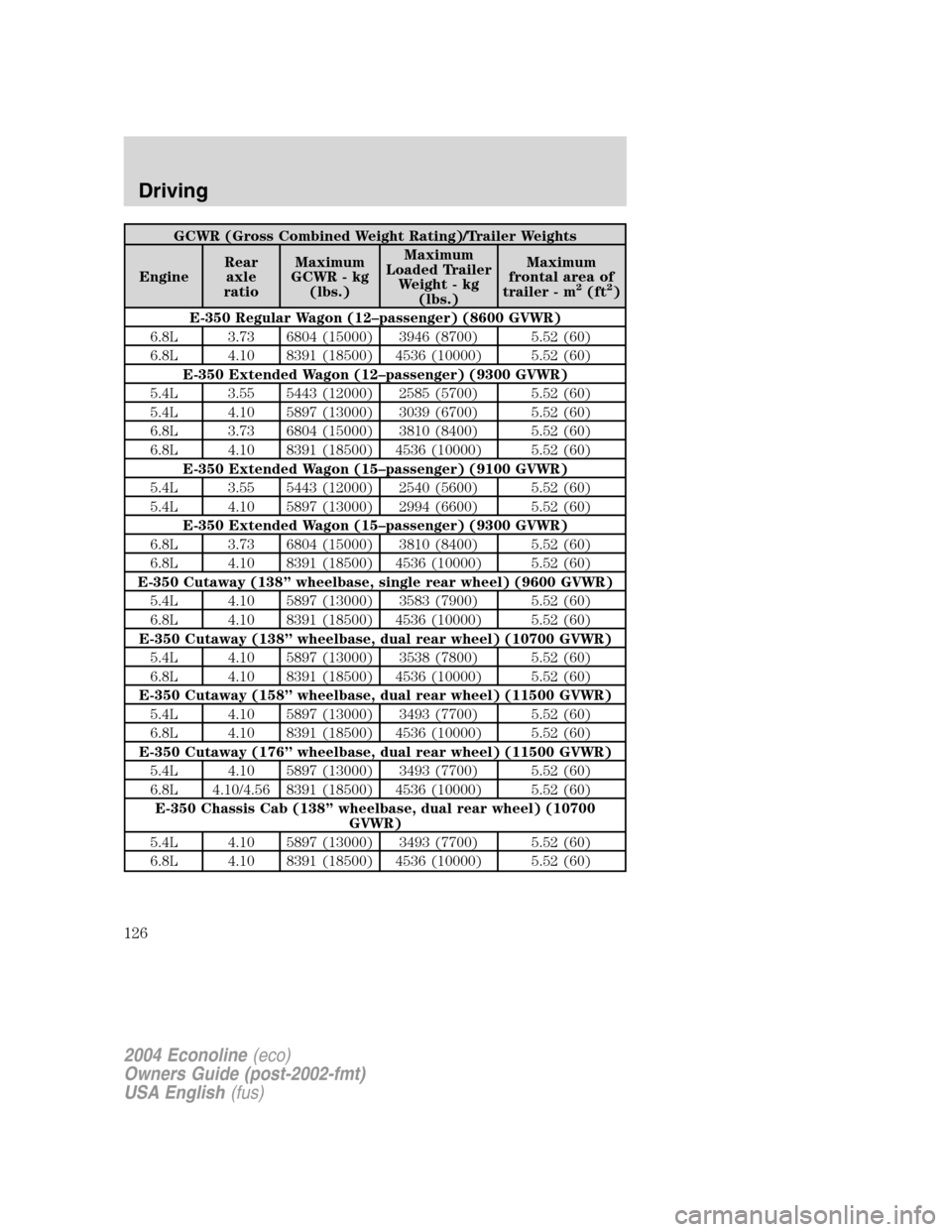
GCWR (Gross Combined Weight Rating)/Trailer Weights
EngineRear
axle
ratioMaximum
GCWR - kg
(lbs.)Maximum
Loaded Trailer
Weight - kg
(lbs.)Maximum
frontal area of
trailer - m
2(ft2)
E-350 Regular Wagon (12–passenger) (8600 GVWR)
6.8L 3.73 6804 (15000) 3946 (8700) 5.52 (60)
6.8L 4.10 8391 (18500) 4536 (10000) 5.52 (60)
E-350 Extended Wagon (12–passenger) (9300 GVWR)
5.4L 3.55 5443 (12000) 2585 (5700) 5.52 (60)
5.4L 4.10 5897 (13000) 3039 (6700) 5.52 (60)
6.8L 3.73 6804 (15000) 3810 (8400) 5.52 (60)
6.8L 4.10 8391 (18500) 4536 (10000) 5.52 (60)
E-350 Extended Wagon (15–passenger) (9100 GVWR)
5.4L 3.55 5443 (12000) 2540 (5600) 5.52 (60)
5.4L 4.10 5897 (13000) 2994 (6600) 5.52 (60)
E-350 Extended Wagon (15–passenger) (9300 GVWR)
6.8L 3.73 6804 (15000) 3810 (8400) 5.52 (60)
6.8L 4.10 8391 (18500) 4536 (10000) 5.52 (60)
E-350 Cutaway (138”wheelbase, single rear wheel) (9600 GVWR)
5.4L 4.10 5897 (13000) 3583 (7900) 5.52 (60)
6.8L 4.10 8391 (18500) 4536 (10000) 5.52 (60)
E-350 Cutaway (138”wheelbase, dual rear wheel) (10700 GVWR)
5.4L 4.10 5897 (13000) 3538 (7800) 5.52 (60)
6.8L 4.10 8391 (18500) 4536 (10000) 5.52 (60)
E-350 Cutaway (158”wheelbase, dual rear wheel) (11500 GVWR)
5.4L 4.10 5897 (13000) 3493 (7700) 5.52 (60)
6.8L 4.10 8391 (18500) 4536 (10000) 5.52 (60)
E-350 Cutaway (176”wheelbase, dual rear wheel) (11500 GVWR)
5.4L 4.10 5897 (13000) 3493 (7700) 5.52 (60)
6.8L 4.10/4.56 8391 (18500) 4536 (10000) 5.52 (60)
E-350 Chassis Cab (138”wheelbase, dual rear wheel) (10700
GVWR)
5.4L 4.10 5897 (13000) 3493 (7700) 5.52 (60)
6.8L 4.10 8391 (18500) 4536 (10000) 5.52 (60)
2004 Econoline(eco)
Owners Guide (post-2002-fmt)
USA English(fus)
Driving
126
Page 127 of 240

GCWR (Gross Combined Weight Rating)/Trailer Weights
EngineRear
axle
ratioMaximum
GCWR - kg
(lbs.)Maximum
Loaded Trailer
Weight - kg
(lbs.)Maximum
frontal area of
trailer - m
2(ft2)
E-350 Chassis Cab (158”wheelbase, dual rear wheel) (11500
GVWR)
5.4L 4.10 5897 (13000) 3447 (7600) 5.52 (60)
6.8L 4.10 8391 (18500) 4536 (10000) 5.52 (60)
E-350 Chassis Cab (176”wheelbase, dual rear wheel) (11500
GVWR)
5.4L 4.10 5897 (13000) 3493 (7700) 5.52 (60)
6.8L 4.10/4.56 8391 (18500) 4536 (10000) 5.52 (60)
E-350 Stripped Chassis (138”wheelbase) (9600 GVWR)
5.4L 3.55/4.10 5897 (13000) 3992 (8800) 5.52 (60)
6.8L 4.10 8391 (18500) 4536 (10000) 5.52 (60)
E-350 Stripped Chassis (158”wheelbase) (9600 GVWR)
5.4L 3.55/4.10 5897 (13000) 3946 (8700) 5.52 (60)
6.8L 4.10 8391 (18500) 4536 (10000) 5.52 (60)
E-350 Stripped Chassis (138”wheelbase) (10000 GVWR)
5.4L 4.10 5897 (13000) 3856 (8500) 5.52 (60)
6.8L 4.10 8391 (18500) 4536 (10000) 5.52 (60)
E-350 Stripped Chassis (158”wheelbase) (10000 GVWR)
5.4L 4.10 5897 (13000) 3810 (8400) 5.52 (60)
6.8L 4.10 8391 (18500) 4536 (10000) 5.52 (60)
E-350 Chassis Cab (158”wheelbase) (11000 GVWR)
5.4L 4.10 5897 (13000) 3810 (8400) 5.52 (60)
6.8L 4.10 8391 (18500) 4536 (10000) 5.52 (60)
E-350 Stripped Chassis (176”wheelbase) (10000 GVWR)
5.4L 4.10 5897 (13000) 3810 (8400) 5.52 (60)
6.8L 4.10 8391 (18500) 4536 (10000) 5.52 (60)
E-350 Stripped Chassis (176”wheelbase) (11000 GVWR)
5.4L 4.10 5897 (13000) 3810 (8400) 5.52 (60)
6.8L 4.10 8391 (18500) 4536 (10000) 5.52 (60)
E-450 Cutaway and Chassis Cab (all wheelbases, all GVWRs)
6.8L 4.56 9072 (20000) 4536 (10000) 5.52 (60)
2004 Econoline(eco)
Owners Guide (post-2002-fmt)
USA English(fus)
Driving
127
Page 128 of 240
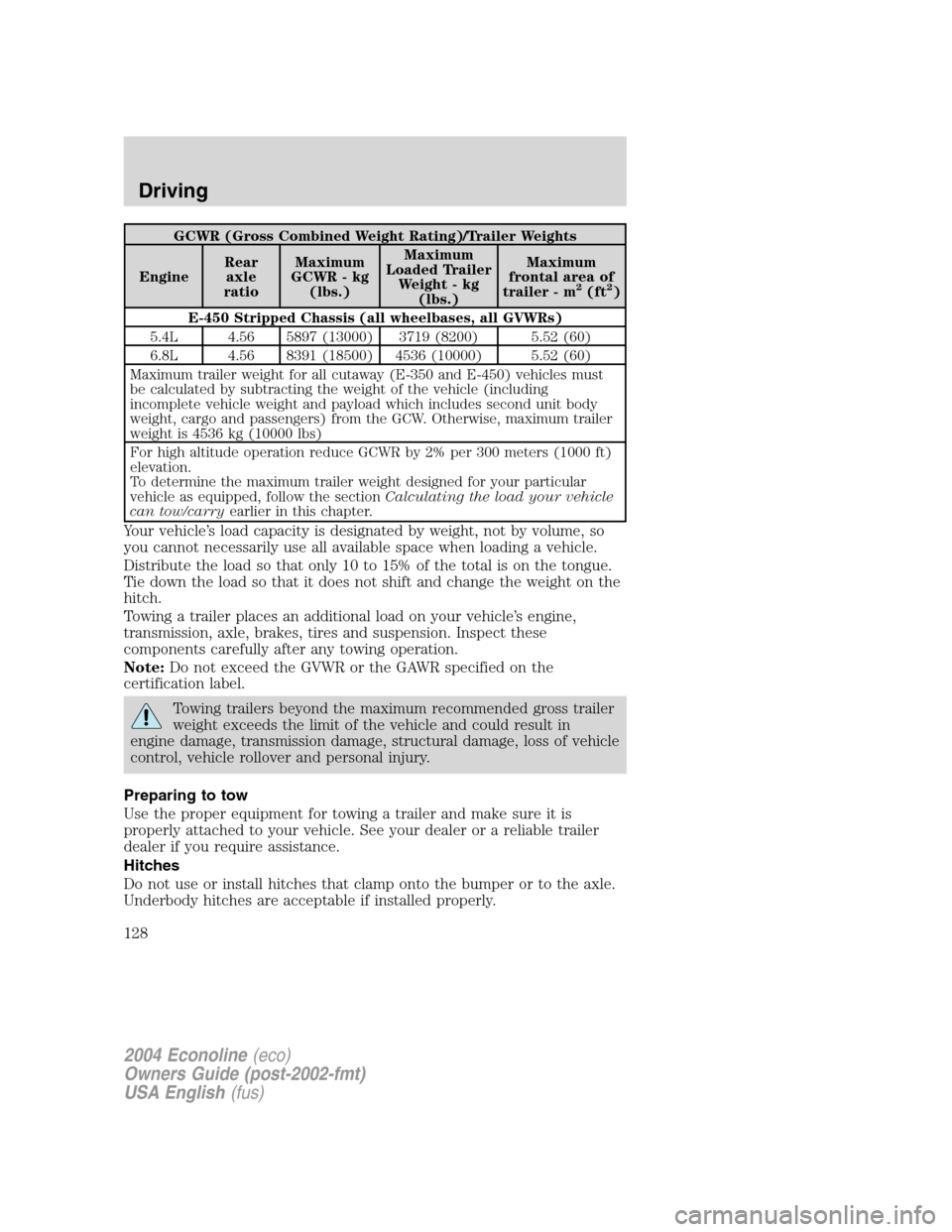
GCWR (Gross Combined Weight Rating)/Trailer Weights
EngineRear
axle
ratioMaximum
GCWR - kg
(lbs.)Maximum
Loaded Trailer
Weight - kg
(lbs.)Maximum
frontal area of
trailer - m
2(ft2)
E-450 Stripped Chassis (all wheelbases, all GVWRs)
5.4L 4.56 5897 (13000) 3719 (8200) 5.52 (60)
6.8L 4.56 8391 (18500) 4536 (10000) 5.52 (60)
Maximum trailer weight for all cutaway (E-350 and E-450) vehicles must
be calculated by subtracting the weight of the vehicle (including
incomplete vehicle weight and payload which includes second unit body
weight, cargo and passengers) from the GCW. Otherwise, maximum trailer
weight is 4536 kg (10000 lbs)
For high altitude operation reduce GCWR by 2% per 300 meters (1000 ft)
elevation.
To determine the maximum trailer weight designed for your particular
vehicle as equipped, follow the sectionCalculating the load your vehicle
can tow/carryearlier in this chapter.
Your vehicle’s load capacity is designated by weight, not by volume, so
you cannot necessarily use all available space when loading a vehicle.
Distribute the load so that only 10 to 15% of the total is on the tongue.
Tie down the load so that it does not shift and change the weight on the
hitch.
Towing a trailer places an additional load on your vehicle’s engine,
transmission, axle, brakes, tires and suspension. Inspect these
components carefully after any towing operation.
Note:Do not exceed the GVWR or the GAWR specified on the
certification label.
Towing trailers beyond the maximum recommended gross trailer
weight exceeds the limit of the vehicle and could result in
engine damage, transmission damage, structural damage, loss of vehicle
control, vehicle rollover and personal injury.
Preparing to tow
Use the proper equipment for towing a trailer and make sure it is
properly attached to your vehicle. See your dealer or a reliable trailer
dealer if you require assistance.
Hitches
Do not use or install hitches that clamp onto the bumper or to the axle.
Underbody hitches are acceptable if installed properly.
2004 Econoline(eco)
Owners Guide (post-2002-fmt)
USA English(fus)
Driving
128